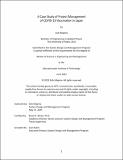A Case Study of Project Management of COVID-19 Vaccination in Japan
Author(s)
Majima, Eishi
DownloadThesis PDF (3.215Mb)
Advisor
Moser, Bryan R.
Terms of use
Metadata
Show full item recordAbstract
COVID-19 vaccination played a critical role in preventing the spread of the disease in the global pandemic. Research on operational mechanisms of COVID-19 vaccination projects is limited compared with the epidemiologic and socio-economic studies. Japan is a unique country with various operational information on COVID-19 vaccinations publicly available. This research evaluated vaccination trends in 49 countries and developed the model of vaccination trends in Japan to understand the operational mechanisms of national-scale projects. The international comparison revealed Japan’s slow vaccine authorizations and yet the 13th earliest and 3rd fastest to achieve the achievement of 70% full vaccination coverage. Globally comparing the daily vaccination trends exhibited a slow pace in Japan’s first 80 days of the vaccination project. The study found the different levels of ceiling effects of vaccine distributions on daily first-dose vaccinations by vaccine category in Japan. Based on the observations, the research developed a system dynamics model on vaccination trends with four operational factors: willing people to take vaccines, daily vaccine deliveries, vaccine stocks on sites, and human resource capacities. The model fit the actual 7-day smoothed daily vaccination trends with the R-squared of 0.943, 0.909, and 0.915 for the total, first, and second doses with Pfizer/BioNTech and Takeda/Moderna vaccines in the primary series in Japan. The simulation predicted cumulative vaccination trends with 70% coverage achievement period errors (percentage errors) of 10 days (4.24%), 12 days (5.41%), and 8 days (3.23%) for the total, first, and second doses, respectively. The developed model was applied to explore room for operational improvement in Japan for resource-saving and acceleration purposes. The experiment demonstrated the potential savings of over 20 thousand healthcare worker recruitments without vaccination delay due to vaccine supply constraints and by a modified team structure in sites with the higher nurse–doctor ratio of 3 or more. For acceleration purposes, the model estimated limited opportunities with human resource management under the vaccine supply constraints, only shortening the 70% full vaccination coverage period by 3 days. This research provides performance metrics and a simulation tool for model-based project planning and management applicable to future pandemics and public emergency responses by practitioners.
Date issued
2023-06Department
System Design and Management Program.Publisher
Massachusetts Institute of Technology